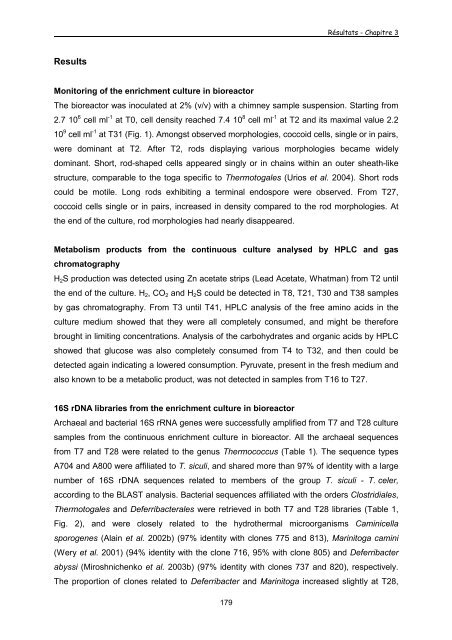THESE Anne POSTEC Diversité de populations microbiennes ...
THESE Anne POSTEC Diversité de populations microbiennes ...
THESE Anne POSTEC Diversité de populations microbiennes ...
Create successful ePaper yourself
Turn your PDF publications into a flip-book with our unique Google optimized e-Paper software.
Résultats - Chapitre 3<br />
Results<br />
Monitoring of the enrichment culture in bioreactor<br />
The bioreactor was inoculated at 2% (v/v) with a chimney sample suspension. Starting from<br />
2.7 10 6 cell ml -1 at T0, cell <strong>de</strong>nsity reached 7.4 10 8 cell ml -1 at T2 and its maximal value 2.2<br />
10 9 cell ml -1 at T31 (Fig. 1). Amongst observed morphologies, coccoid cells, single or in pairs,<br />
were dominant at T2. After T2, rods displaying various morphologies became wi<strong>de</strong>ly<br />
dominant. Short, rod-shaped cells appeared singly or in chains within an outer sheath-like<br />
structure, comparable to the toga specific to Thermotogales (Urios et al. 2004). Short rods<br />
could be motile. Long rods exhibiting a terminal endospore were observed. From T27,<br />
coccoid cells single or in pairs, increased in <strong>de</strong>nsity compared to the rod morphologies. At<br />
the end of the culture, rod morphologies had nearly disappeared.<br />
Metabolism products from the continuous culture analysed by HPLC and gas<br />
chromatography<br />
H 2 S production was <strong>de</strong>tected using Zn acetate strips (Lead Acetate, Whatman) from T2 until<br />
the end of the culture. H 2 , CO 2 and H 2 S could be <strong>de</strong>tected in T8, T21, T30 and T38 samples<br />
by gas chromatography. From T3 until T41, HPLC analysis of the free amino acids in the<br />
culture medium showed that they were all completely consumed, and might be therefore<br />
brought in limiting concentrations. Analysis of the carbohydrates and organic acids by HPLC<br />
showed that glucose was also completely consumed from T4 to T32, and then could be<br />
<strong>de</strong>tected again indicating a lowered consumption. Pyruvate, present in the fresh medium and<br />
also known to be a metabolic product, was not <strong>de</strong>tected in samples from T16 to T27.<br />
16S rDNA libraries from the enrichment culture in bioreactor<br />
Archaeal and bacterial 16S rRNA genes were successfully amplified from T7 and T28 culture<br />
samples from the continuous enrichment culture in bioreactor. All the archaeal sequences<br />
from T7 and T28 were related to the genus Thermococcus (Table 1). The sequence types<br />
A704 and A800 were affiliated to T. siculi, and shared more than 97% of i<strong>de</strong>ntity with a large<br />
number of 16S rDNA sequences related to members of the group T. siculi - T. celer,<br />
according to the BLAST analysis. Bacterial sequences affiliated with the or<strong>de</strong>rs Clostridiales,<br />
Thermotogales and Deferribacterales were retrieved in both T7 and T28 libraries (Table 1,<br />
Fig. 2), and were closely related to the hydrothermal microorganisms Caminicella<br />
sporogenes (Alain et al. 2002b) (97% i<strong>de</strong>ntity with clones 775 and 813), Marinitoga camini<br />
(Wery et al. 2001) (94% i<strong>de</strong>ntity with the clone 716, 95% with clone 805) and Deferribacter<br />
abyssi (Miroshnichenko et al. 2003b) (97% i<strong>de</strong>ntity with clones 737 and 820), respectively.<br />
The proportion of clones related to Deferribacter and Marinitoga increased slightly at T28,<br />
179
















